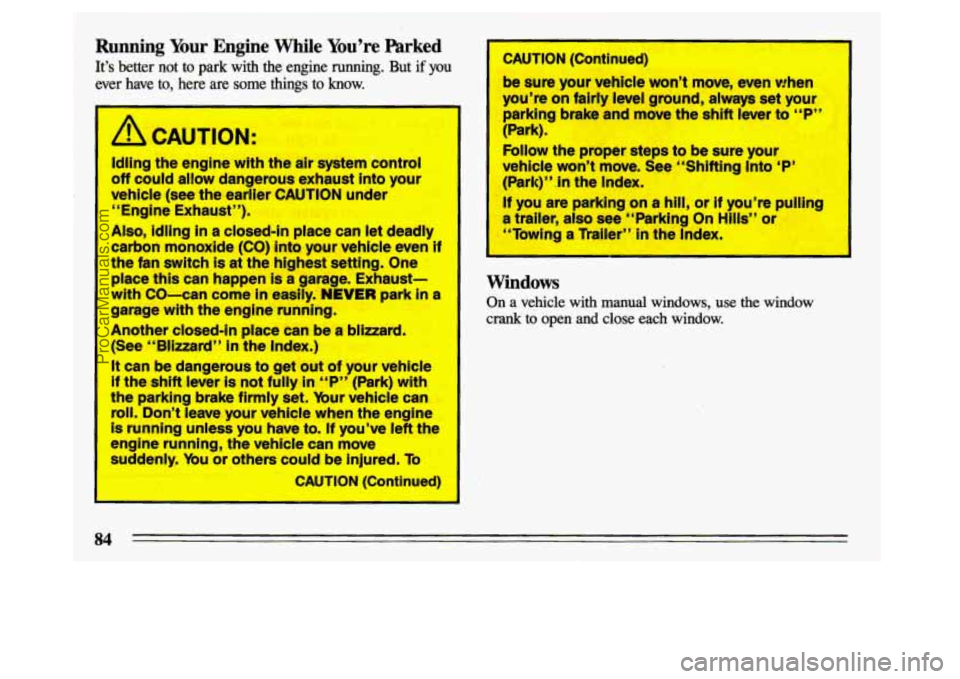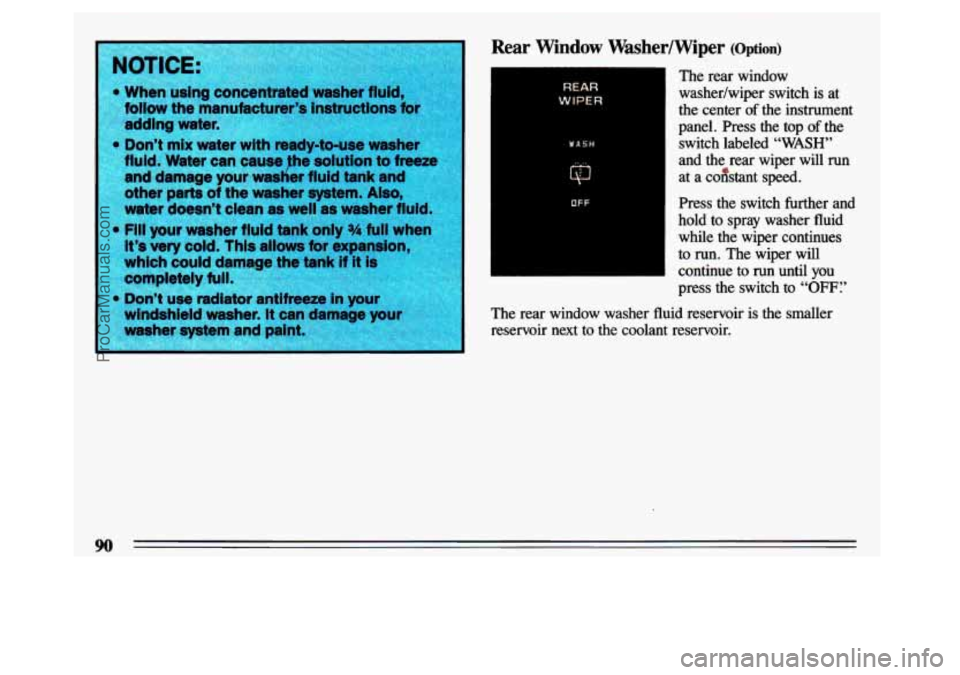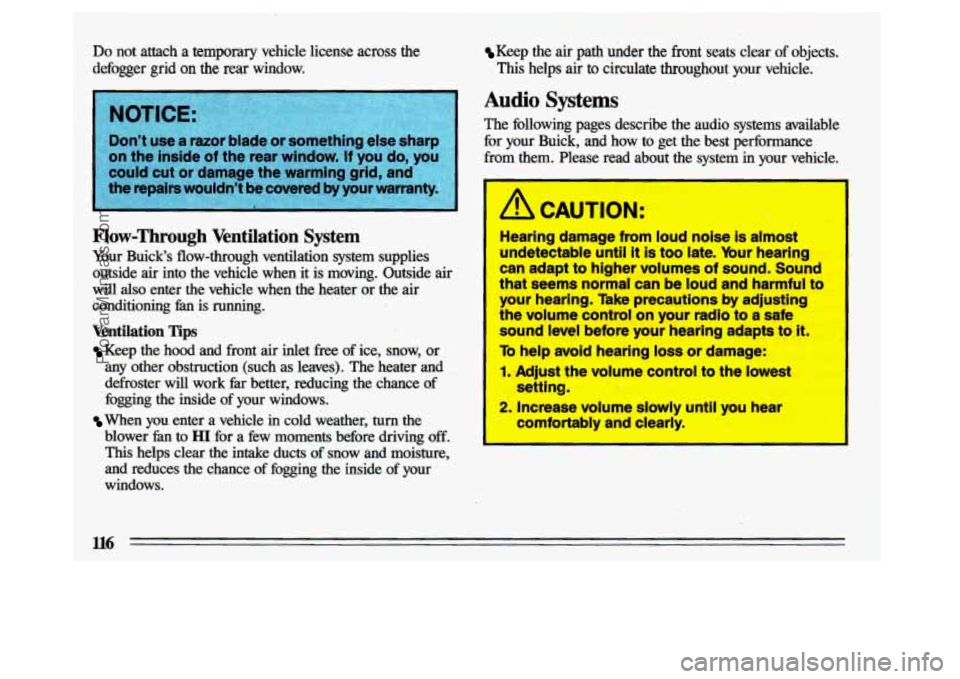1993 BUICK CENTURY window
[x] Cancel search: windowPage 86 of 324

Running Your Engine While You’re Parked
It’s better not to park with the engine running. But if you
ever have to, here are some things to know.
1
I a CAUTION: I
Idling the engine with the air system “control
off could allow dangerous exhaust into your
vehicle (see the earlier
CAUTION under
“Engine Exhaust”).
Also, idling In a closed-in place can let deadly
carbon monoxide
(CO) into your vehicle even if
the fan switch is at the hlghest setting. One
place this can happen
is a garage. Exhaust-. -
with C0-n come in easily.’ NEVER park in a
garage wlth the engine running.
Another closed-in place can
be a blizzard.
It can be dpngeroua to get out of your vehicle
If the shift lever is not fully On “P” (Park) wlth
the parking
brake firmly set. bur vehicle can
roll. Don’t leave your vehicle when the engine
Os runnhg unless you. have to. If you’ve left the
engine running, the vehicle can move
suddenly.
Nu or others could be injured. To
I
I
I (See “Blizzard” In.the Index.)
CAUTION (Continued)
- - - -
I CAUTION (C __ ____ Jued) ..
be sureyour vehicle won’t move, even when
you’re on fairly level ground, always set your
parking
brake and move the shift lever to “P”,
(Park).
Follow the proper steps to be &re your
vehicle won’t move.
See “Shifting Into ‘P’
(Park)”.in the Index.
If you are parking on
a hill, or if you’re pulling
a trailer, also see “Parking On Hills” or
“Towing
a Thiler” in the Index.
i
Windows
On a vehicle with manual windows, use the window
crank
to open and close each window.
84
ProCarManuals.com
Page 87 of 324

Power Windows (Option)
*.”
._
Flip-Open Rear Vent Windows (Option, Wagon)
With power windows, switches on the driver’s armrest
control each
of the windows when the ignition is on. In
addition, each passenger door has a control switch for its
own window. To open, pull the latch forward, then push on the center
of the latch to swing the window out into the open
position.
To close the window, pull the center of the latch and then
press the latch into the closed position.
85
ProCarManuals.com
Page 91 of 324

Low Speed Delay Wipers (Option)
You can set the wiper speed for a long or short delay
between wipes.
‘ms can be very useful in light rain or
snow.
Turn the band to choose the delay time. The closer
to
“LO:’ the shorter the delay.
If you push the paddle less than one second, washer fluid
will spray three to four times while the wiper blades
cycle.
If you push the paddle longer than one second,
washer fluid will spray as long
as the paddle is held.
When you release the paddle, the wiper blades will cycle
I
- .I - three to four more times. 1
A CAUTION:
I If you have the standard wipers, the wipers will keep
going
in “LO” until you turn the wiper control to -
“OFF.” Damaged wiper blades may prevent you’irom
seeing well enough to drive safely.
To avoid If you have the optional low speed delay wipers, the
damage, be sure to clear ice and snow from wipers will clear the window and then either stop or
the wiper blades before using them. If they’re
frozen to the windshield, carefully loosen or
thaw them.
If your blades do become b 1.
-
return to your preset speed.
I damaged, gefnew blades or blade inserts.
I
Heavy snow or ice can overload your wipers. A circuit
breaker in the motor will
stop them until the motor cools.
Clear away snow or ice to prevent an overload.
Windshield Washer
At the top of the turn signal/headlight beam lever there’s
a paddle with the word “PUSH”
on it. To spray washer
fluid on the windshield, push the paddle.
a Driving without washer fluid can be dangerous.
A bad mud splash can block your vislon. ybu
could hit another vehicle or go off the mad.
Check your washer fluid level often.
* In freezing weather, don’t use your washer
untll the windshield is warmed. Otherwim
the washer fluid
can form ice on the
windshield, blocking
put vision.
ProCarManuals.com
Page 92 of 324

Rear Window Washedwiper (Option)
REAR
WIPER
WASH
rt-r
OFF
I
The rear window
washedwiper switch is at
the center
of the instrument
panel. Press the top
of the
switch labeled
“WASH”
I
and the rear wiper will run
at a coastant speed.
Press the switch further and
hold to spray washer fluid
while the wiper continues
to run. The wiper will
press the switch to
‘‘OFF?
- continue to run until you
The rear window washer fluid reservoir is the smaller
reservoir next to the coolant reservoir.
90
ProCarManuals.com
Page 103 of 324

To prevent damage or loss of cargo as you’re driving,
check now and then to make sure the luggage carrier and
cargo are still securely hstened.
Convenience Net (Option, coupe and Sedan)
Your vehicle may have a convenience net. You’ll see it
just inside the back wall
of the trunk.
Put small loads, like grocery bags, behind the net.
It can
help keep them
fkom falling over during sharp turns or
quick
starts and stops. The net isn’t for larger, heavier loads. Store them in the \
trunk as fhr forward
as you
can. You can unhook the net
so that it will lie flat when you’re not using it.
You can also purchase a convenience net from your
dealer.
Cargo Security Cover (Option, Wagon)
This cover is designed to help conceal articles in the rear
storage area. It pulls out and retracts like
a window
shade.
If you have the optional rear-facing third seat, make
sure
it is folded down.
A CAUTION:
An improperly stored cargo cover could be
-brown about the vehicle during a collision or
sudden maneuver. You or others
could be
injured. If you remove the cover, remove it
from the vehicle. When you put it back, always
be sure that it is securely reattached.
ProCarManuals.com
Page 116 of 324

1
Your Buick Comfort Control
Syst m -
The air conditioner and heater work best if you keep
your windows closed while using them. Your vehicle
also
has the flow-through ventilation system described later in
this section.
Lever Controls: The upper lever changes the functions
of your system. The lower lever changes the temperature
of the air coming through the system.
3f : Selects the force of air you want.
Air Conditioning
The upper lever has three air conditioner settings. On
very hot days, open the windows long enough to let hot
inside air escape.
This reduces the amount of work your
air conditioner's compressor
will have to do, which
should help fuel economy.
MAX: Provides maximum cooling with the least amount
of work. This setting recirculates much of the air inside
your vehicle
so it maximizes your air conditioner's
performance and
fuel economy.
NORM (Normal): Use for normal cooling on hot days.
This setting cools outside air and directs it through the
instrument panel outlets.
BI-LEV (Bi-Level): Use this on cool, but sunny days.
This setting brings in the outside air, but directs it in two\
ways. The cool air
is directed to the upper portion of
your body through the instrument panel
outlets, but
warmed air is directed through the heater ducts and
defroster vents. At times
this temperature difference may
be more apparent than others.
To turn the 5x1 off, move the upper lever to the OF'F position.
ll4
ProCarManuals.com
Page 117 of 324

The air conditioner compressor operates in all AIR COND
positions, and in DEF (Defrost) when the outside
temperature is above about 40°F (4.5"
C).
Ventilation
For mild outside temperatures, when little heating or
cooling is needed, slide the upper lever to
VENT. Air
flow is through the instrument panel outlets. Rotate the
control next to the outlets to turn on, adjust or
turn off
the air flow. Adjust the lower lever on the control panel
to the temperature desired.
Heating
When outside temperatures are cold, sliding the upper
lever to
HEATER and the lower lever to HOT will send
heated air through the heater ducts, and some through the
defroster vents.
VENT and HEAmR are labeled
ECONOMY positions because the air conditioner
compressor doesn't run
in these two settings. This
reduces engine load, resulting
in improved he1 economy.
If either setting fails to keep you comfortable, or causes
your windows
to fog up, slide the upper lever to one of
the
AIR COND positions, or to DEF (Defrost).
Defrosting
The DEF setting directs most of the air through the
defroster vents, and some through the heater ducts.
Defogging Windows with Four Season
Climate Control
To quickly defog the windshield, set the upper lever to
DEF and move the hn switch to HI. Slide the lower
lever
to HOT.
In damp, cool weather (temperatures about 45"-65"F,
7"- 18" C), you can use BI-LEV to defog the side windows.
Set the upper lever to
BI-LEV and the fan switch to HI.
Aim the side vents toward the side windows. For increased
air flow to the side vents, close the center vents.
Rear Window Defogger (Option)
--
The rear window defogger
uses
a warming grid to
remove fog from the rear
window.
In winter, it can
also keep ice from forming
on the rear window.
Press the
ON portion of the
switch. The indicator light
will glow. The rear window
defogger will
turn off
automatically after about
10
minutes of use. You can
also turn
it off by turning
off the ignition or pressing the
OFF portion of the
switch.
ProCarManuals.com
Page 118 of 324

Keep the air path under the front seats clear of objects.
Do not attach a temporary vehicle license across the
defogger grid
on the rear window.
Flow-Through Ventilation System
Your Buick's flow-through .ventilation system supplies outside
air into the vehicle when it is moving. Outside air
will
also enter the vehicle when the heater or the air
conditioning fan is running.
Ventilation Tips
Keep the hood and front air inlet free of ice, snow, or
any other obstruction (such as leaves). The heater and
defroster will work
far better, reducing the chance of
fogging the inside of your windows.
blower fan to
HI for a few moments before driving off.
This helps ,clear the intake ducts of snow and moisture,
and reduces the chance of fogging the inside of your
windows.
When you enter a vehicle in cold weather, turn the This helps
air to circulate throughout your vehicle.
Audio Systems
The
following pages describe the audio systems available
for your Buick, and how to get the best performance
frorr
*hmm Please read about the system in your vehicle.
A CAUTION:
Hearing damage from loud noise is almost
undetectable until
it is too'late. Your hearing
can adapt to higher volumes of sound. Sound
that seems normal can be loud and harmful to
-3ur hearing. Take precautions by adjusting
..re volume control on your radio to a safe
sound level before your hearing adapts to
it.
To help avoid hearing loss or damage:
1. Adjust the volume control to the lowest
-. Increase volume slowly until you hear
setting.
comfortably and clearly.
I
ProCarManuals.com